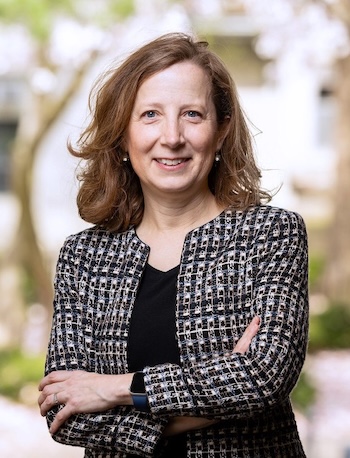Karen Smilowitz
Fall 2025 Interview

Karen Smilowitz, PhD
Associate Provost for Undergraduate Education, Office of the Provost
James N. and Margie M. Krebs Professor of Industrial Engineering and Management Sciences, McCormick School of Engineering and Applied Science
Professor of Operations, Kellogg Schools of Management
By Kate Flom Derrick, Assistant Director of Reflective Pedagogy
On September 1, Karen Smilowitz officially started as the Associate Provost for Undergraduate Education in the Office of the Provost. She teaches in the McCormick Schools of Engineering as well as the Kellogg School of Management.
Earlier this month, I had a lovely conversation with Dr. Smilowitz, a former Searle Fellow, about deepening reflective, evidence-informed, and innovative pedagogical practices. The following is an excerpt from our conversation.
Are there any pedagogical innovations you’ve seen recently that inspire you or align with your vision for undergraduate education?
There's an exciting opportunity to think about what undergraduate education will look like in the age of AI. I say this as an engineer, it is amazing in the way AI breaks down barriers to access programming languages for our students, for software that we use. Many barriers to good programming, like not knowing syntax, go away. There's still a human need for creativity and logic in all of this. But how does that change other disciplines?
Just today, a faculty member in Radio/Television/Film said he’s thinking about AI and the curriculum in RTVF and asked, “Are there any resources?” And I said, “Absolutely,” and cc’ed Jen [Senior Director, Searle Center] and Vicky [Senior Director, Teaching and Learning Technologies]. It's a great opportunity, because there's so much good content that's coming out of Searle and coming out of TLT that faculty really need at this point. Helping Searle to have the capacity to respond to department-specific requests is something I'm interested in. I come to this role with a STEM perspective, but then I'm really excited about the opportunity to think about what this means in other fields.
You’ve spoken about the importance of incentivizing good teaching at Northwestern. What are some ways we can signal the value of ongoing professional growth?
Searle provides so many opportunities for faculty to think intentionally about their teaching. Something that Sumit Dhar, Associate Provost for Faculty, and I have talked a lot about is: How do we complete that cycle to make sure these efforts to improve teaching are reflected at the end of the year?
There has been considerable work at Northwestern before I arrived in this role on reimagining CTECs. Many would acknowledge that CTECs are not perfect—we need work there. CTECS allow us to look at evaluation at scale but should not be the only mechanism. Our task now is to introduce compliments to CTECs.
There have been some fantastic ideas across the University and a lot of great ideas from the Center. Searle is partnering with the departments—in fact, my own home department—on teaching observation rubrics.
All of this fits well with the work that Searle’s doing around the Assessment Cycle. As we think about measuring student learning outcomes as a way to improve curriculum, this is also a way to think about teaching. I’m excited to tap into the assessment cycle framework and the infrastructure that has been built around assessment at Northwestern. This was great for accreditation, and we can continue to expand the assessment work to improve teaching and curriculum development.
I am excited when I talk to the team at Searle because they focus not only on improving teaching in a single classroom but looking at the curriculum as a whole. Providing departments with the resources to do that can be quite helpful given the expertise at Searle related to curriculum development.
With the Assessment Gallery and the Assessment Cycle and all the work that’s come out of Searle, we aren’t only looking 10 years ahead at the next accreditation cycle. We can focus each year on using the work on assessment to improve teaching and learning at Northwestern. As a bonus, accreditation will be easier. The extra win is the way that we can assess curriculum and teaching and student learning year over year.
What did you find promising about McCormick’s teaching evaluation rubric and its alignment with the Reimagine CTEC committee’s goal to pluralize the ways we evaluate effective teaching and learning?
This is a fantastic opportunity to compliment CTEC evaluations with structured observations. I also see great value is sharing the rubric ahead of time with faculty so that they can better understand the metrics by which their teaching is evaluated.
What advice would you offer to faculty who aspire to become change agents in their own departments or disciplines?
Creating connections across the University is really important. I was a Searle Fellow, and it was a great experience. When I began my career at Northwestern, there were three assistant professors in my department. The Searle Fellows program gave me a chance to meet other junior faculty across the University. That’s where a lot of my early friends here came from. This creates a great sense of community across the University.
In a recent email to fall instructors, we highlighted the resources available at Searle, in particular, the new information on how to make your syllabus more transparent with this idea of the hidden curriculum. Being open and transparent with students at the beginning of the quarter and setting expectations can go a long way for a successful teaching experience.
...
I have such good memories of my time as both a Searle Fellow and a Searle Mentor. I’m excited to continue my work with Searle in this new role.